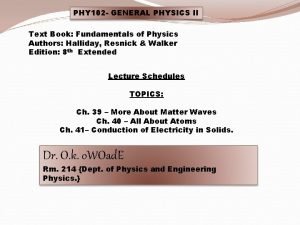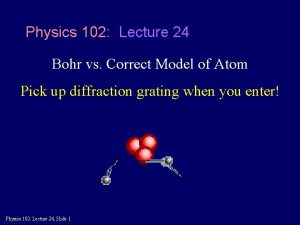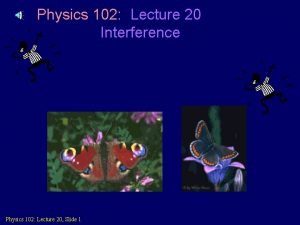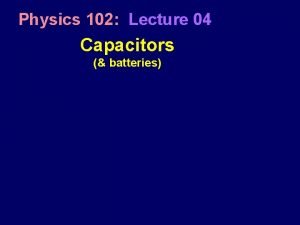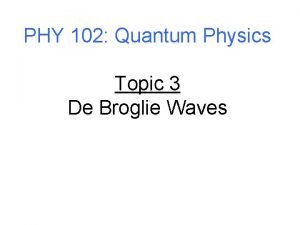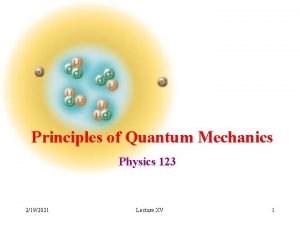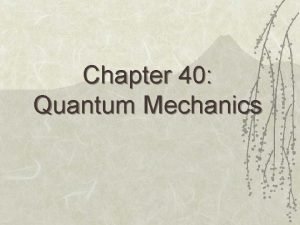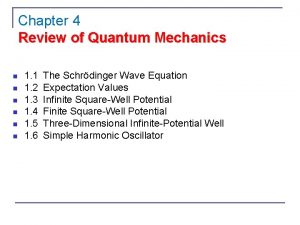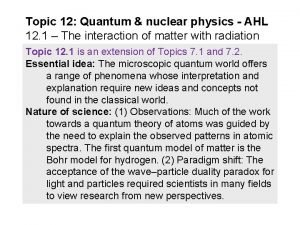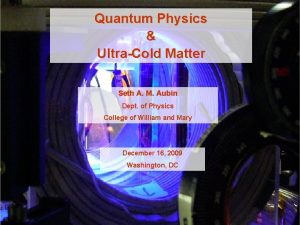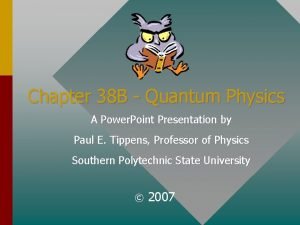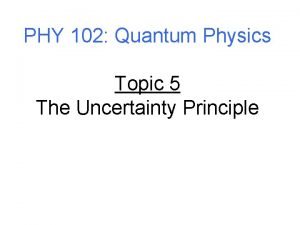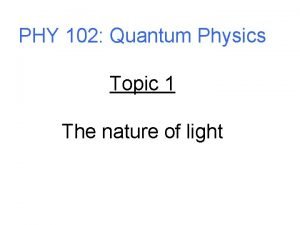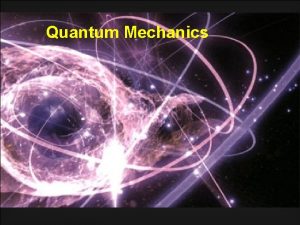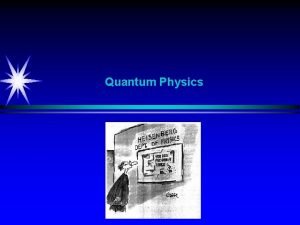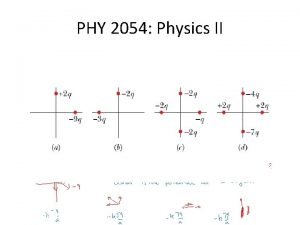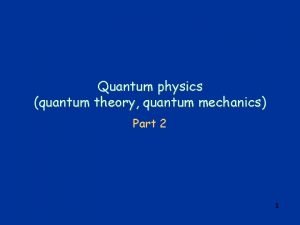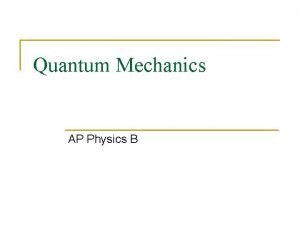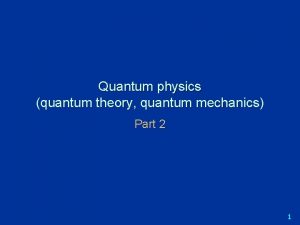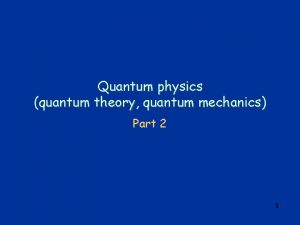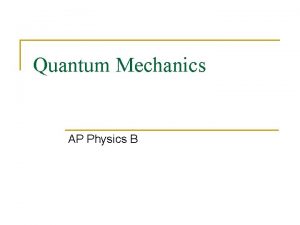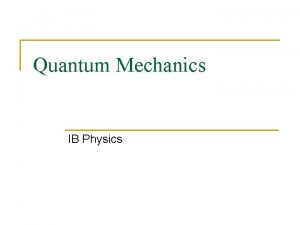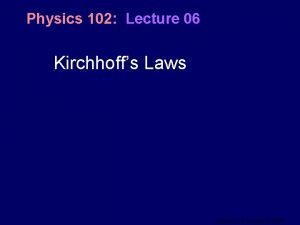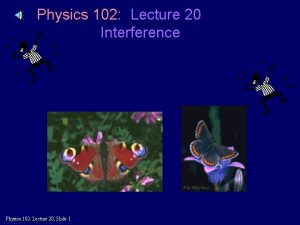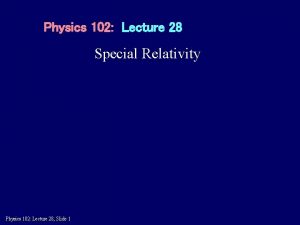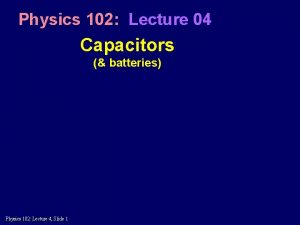PHY 102 Quantum Physics Topic 4 Introduction to
























- Slides: 24

PHY 102: Quantum Physics Topic 4 Introduction to Quantum Theory

• Wave functions • Significance of wave function • Normalisation • The time-independent Schrodinger Equation. • Solutions of the T. I. S. E

The de Broglie Hypothesis In 1924, de Broglie suggested that if waves of wavelength λ were associated with particles of momentum p=h/λ, then it should also work the other way round……. A particle of mass m, moving with velocity v has momentum p given by:

Kinetic Energy of particle If the de Broglie hypothesis is correct, then a stream of classical particles should show evidence of wave-like characteristics………………………

Standing de Broglie waves Eg electron in a “box” (infinite potential well) V= V=0 Electron “rattles” to and fro V= V=0 Standing wave formed

Wavelengths of confined states In general, k =nπ/L, n= number of antinodes in standing wave

Energies of confined states

Energies of confined states

Particle in a box: wave functions From Lecture 4, standing wave on a string has form: Our particle in a box wave functions represent STATIONARY (time independent) states, so we write: A is a constant, to be determined……………

Interpretation of the wave function The wave function of a particle is related to the probability density for finding the particle in a given region of space: Probability of finding particle between x and x + dx: Probability of finding particle somewhere = 1, so we have the NORMALISATION CONDITION for the wave function:

Interpretation of the wave function

Interpretation of the wave function Normalisation condition allows unknown constants in the wave function to be determined. For our particle in a box we have WF: Since, in this case the particle is confined by INFINITE potential barriers, we know particle must be located between x=0 and x=L →Normalisation condition reduces to :

Particle in a box: normalisation of wave functions

Some points to note…………. . So far we have only treated a very simple one-dimensional case of a particle in a completely confining potential. In general, we should be able to determine wave functions for a particle in all three dimensions and for potential energies of any value Requires the development of a more sophisticated “QUANTUM MECHANICS” based on the SCHRÖDINGER EQUATION…………………

The Schrödinger Equation in 1 -dimension (time-independent) KE Term PE Term

Solving the Schrodinger equation allows us to calculate particle wave functions for a wide range of situations (See Y 2 QM course)……. Finite potential well WF “leakage”, particle has finite probability of being found in barrier: CLASSICALLY FORBIDDEN

Solving the Schrodinger equation allows us to calculate particle wave functions for a wide range of situations (See Y 2 QM course)……. Barrier Penetration (Tunnelling) Quantum mechanics allows particles to travel through “brick walls”!!!!

Solving the SE for particle in an infinite potential well So, for 0<x<L, the time independent SE reduces to: General Solution:

Boundary condition: ψ(x) = 0 when x=0: →B=0 Boundary condition: ψ(x) = 0 when x=L:

In agreement with the “fitting waves in boxes” treatment earlier………………. .

Molecular Beam Epitaxy: Man-made potential wells for Quantum mechanical engineering

Molecular Beam Epitaxy: Man-made potential wells for Quantum mechanical engineering

Quantum Cascade Laser: Engineering with electron wavefunctions

Scanning Tunnelling Microscope: Imaging atoms
 Origin of quantum mechanics
Origin of quantum mechanics Quantum physics vs quantum mechanics
Quantum physics vs quantum mechanics Physics 102
Physics 102 Uiuc physics 102
Uiuc physics 102 Physics 102
Physics 102 Physics 102 final exam
Physics 102 final exam Electric potential lecture
Electric potential lecture Physics 102
Physics 102 Physics 102
Physics 102 Physics 102
Physics 102 Physics 102
Physics 102 Csc 102 introduction to problem solving
Csc 102 introduction to problem solving Physics topic 12
Physics topic 12 Quantum physics wave function
Quantum physics wave function Pn junction khan academy
Pn junction khan academy Beta plus decay
Beta plus decay Quantum physics wave function
Quantum physics wave function Time dependent schrodinger wave equation
Time dependent schrodinger wave equation Physics topic 12
Physics topic 12 Quantum physics summary
Quantum physics summary Quantum physics summary
Quantum physics summary Quantum physics in hindi
Quantum physics in hindi Broad topic and narrow topic examples
Broad topic and narrow topic examples Narrow
Narrow Phy 131 past papers
Phy 131 past papers




